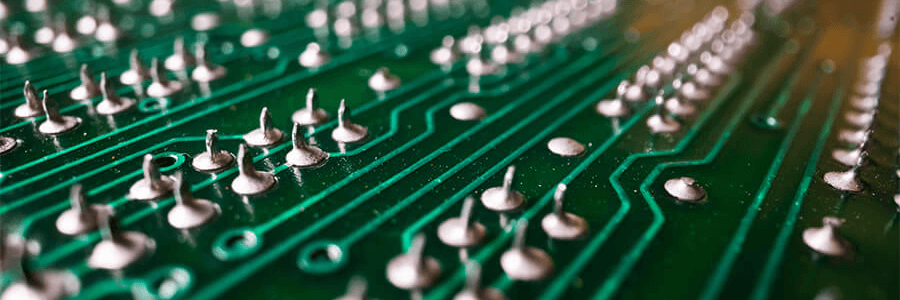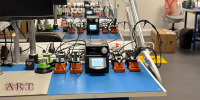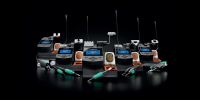


Poor solder joints are the bug bare of even the most seasoned soldering technician. Defining the root cause can be tricky. But often, a poor soldering wetting process is the hidden culprit.
In this article, we give you the 101 guide to the solder wetting process. Our tried and trusted tips can help you to prevent poor wetting, creating soldering joints that stand the test of time!
What Is The Soldering Wetting Process?
Firstly, let's define exactly what the wetting process entails.
The act of soldering involves joining two metals together through a solder alloy. It creates a permanent joint that fuses the two metals together. For this process to take place, a wetting process must have taken place behind the scenes.
The wetting process is where the metal in the solder bonds with the metal on your PCB or components . The solder will become fluid and stick to the component, creating the solder joint that your process requires.
In order for the wetting process to occur, the environment requires specific needs. You will need the following:
- A clean copper surface free of any contamination.
- To reach the ideal temperature.
Some metals are more receptive to the wetting process than others. Whilst others present a challenge.
Why Is The Wetting Process Important For Soldering?
A proper metal joining is only formed where good solder wetting has taken place. It is crucial to the overall strength of the solder joint.
If this does not occur, it can lead to many common soldering problems such as bad joints that will not last. Often these joints will fail the quality control process that your company has in place.
Poor wetting in your soldering application can therefore be the root cause of poor soldering performance.
But lets take a look at what can lead to poor solder wetting.
Factors That Can Impact The Wetting Process
Commonly there are 4 high risk factors that can impair the wetting process for your soldering application. We will outline these below:
Oxidised Soldering Cartridge – If the soldering cartridge that you are using has suffered from oxidisation, the wetting capabilities are severely hampered. This is because oxidisation creates a barrier that impacts the smooth flow of solder, and the wetting process. Oxidisation is often caused by using an untinned tip at too high of a temperature.
Inadequate Heating Temperatures – Both cold or overheated soldering joints are bad news for the soldering wetting process. If you underheat the solder you will not allow it to reach the optimal fluidity level. This prevents the solder from contacting the component adequately. At the other end of the spectrum, if the solder is too high, you impede the wetting process as the solder is rapidly burnt off as vapor.
Insufficient Soldering Technique – Another cause of poor wetting is the technique that the operator employs. Too much pressure or an extended period of time with the soldering tip in contact of the component burns the flux or even damages the component. As stated above, too much heat, or a lack of flux can severely hamper your wetting process.
Ways To Prevent Poor Wetting Whilst Soldering
There are some simple rules to follow to enhance the likelihood of good solder wetting. They help create an environment that is perfectly suited to helping the soldering wetting process.
Clean & Well-Maintained Environment
Where there are any kind of contaminant, dirt or moisture present on your PCB, the wetting process begins to be hampered. It is always generally advised to clean the PCB you are working on prior to the soldering process. This way, any grease or dirt that can effect the wetting of solder is removed. Solvent wipes or PCB cleaning products can be used for this.
Tinned Soldering Cartridges
The process of tinning your soldering tips aids in preventing oxidisation. This must be integrated into part of your soldering clear down routine. Add solder to your hot tips before cleaning them away and turning the station off. This will improve the wetting process, along with prolonging the shelf life of your soldering cartridges.
High Activity Solder Paste
When utilising solder paste in your application, you should always look toward using high activity solder paste. This provides a better wetting process. They also aid in assisting wetting during the reflow process.
Flux Choice
The flux that is used in your soldering application has a cleaning effect that can give provide better wetting. It can help to clear surface oxides, particularly if a stronger flux is used. Flux can also be used as a means of improving heat transfer, particularly for rework applications.
Preheated Soldering Iron/PCB
By preheating your PCB, you can both better activate your flux, and prevent oxidisation. Both benefits will enhance the wetting process in your soldering application. Besides from this, there are also many other benefits to preheating your PCBs, as preheating is an important part of PCB assembly.
To Conclude
We hope that this post has helped to shed some light on the importance of the solder wetting process. It is key to every soldering application.
Knowing the causes of poor wetting, along with some handy tips to improve it, will only improve your soldering performance.
Remember, if you notice poor wetting from a soldering joint, it is not the end of the world. You can always repair the joint by letting it cool, removing the flux and reheating the joint to start again.
Contact our experts if you have any further questions regarding solder, flux or equipment that can improve your soldering wetting performance.














